Gender and Inclusion
Gender, age, abilities and other individual or context-specific characteristics present different opportunities and challenges to provide CVA to people in crisis in a dignified manner.
Among humanitarian actors, there is an increasing acknowledgement of the specific needs and constraints of people of differing abilities, older people, people of different genders, particularly women, and people on the move. Alongside this is a growing appreciation of the need for tailored and sensitive measures that ensure their effective inclusion.
Supporting the needs of diverse people with CVA goes beyond making them a target group; it is about meaningful engagement, purposive design and implementation, and programme adjustment to meet different groups’ needs with dignity. Inclusive approaches go hand in hand with people-centred aid.
Current priorities
The CALP Network will continue to encourage cash actors to widen their focus to be more inclusive and champion a fuller understanding of how CVA can go beyond the notion of ‘do no harm’ towards appropriately addressing the needs of diverse people in safe and dignified manners.
We will work to elevate the experiences and initiatives on CVA and gender, disability inclusive CVA, working with different ethnicities and cultural identities, minority groups, people with diverse sexual identities, and age groups.
CALP will also strive to make its work as accessible as possible.
Featured content

Collected Papers on Gender and Cash Transfer Programmes in Humanitarian Contexts
Report
Existing gender inequalities mean that disasters and conflicts impact women, men, girls and boys differently. Cash based assistance is one of the most significant developments in humanitarian assistance in recent years. But the relationship between gender and cash based assistance in humanitarian contexts is poorly understood. All too often, interventions are designed based on assumptions...

Microlearning video: CVA and Gender
Blog Post
This video provides an overview of the relationship between gender and cash and voucher assistance (CVA) structured around the humanitarian project cycle, which include: Assessment and response analysis: How to adjust the assessment processes to achieve a more accurate reflection of gender and markets. Design and implementation: How to use methods and protocols to reduce the potential...
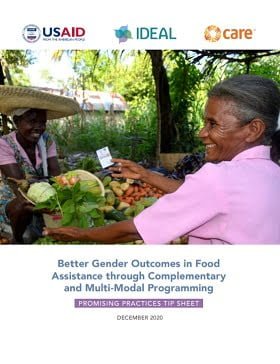
Better Gender Outcomes in Food Assistance through Complementary and Multi-Modal Programing: Promising Practices Tip Sheet
Guidelines and Tools
This Tip Sheet is excerpted from the research report, “Better Gender Outcomes in Food Assistance through Complementary and Multi-Modal programming,” and gives promising practices by the cycles of project cycle management, as well as at the response level. Additionally, there are expert tips and wisdom practices that support the use of a gendered approach in development or humanitarian...

Cash & Voucher Assistance and Gender-Based Violence Compendium
Guidelines and Tools
The Compendium is intended as a companion to the 2015 Inter-Agency Standing Committee (IASC) Guidelines for Integrating Gender-Based Violence Interventions in Humanitarian Action and its companion resource, the GBV Pocket Guide. The guidance was developed through the efforts of 15 organizations who contributed expertise in the inception, design and review of the document. The process was led...
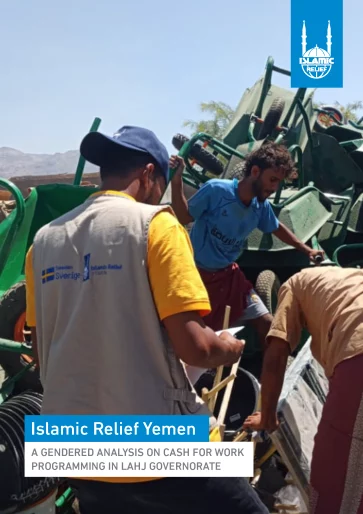
A Gendered Analysis on Cash for Work Programming in Lahj Governorate
Case Study
Cash for Work (CFW) programmes are designed to help the most vulnerable people meet their essential and basic needs. In Yemen, CFW interventions are responding to an ever-growing proportion of the Yemeni population that are in need of humanitarian assistance. Working with communities in the targeted areas of Hudayda and Lahj, the Swedish International Development Cooperation Agency SIDA-funded...
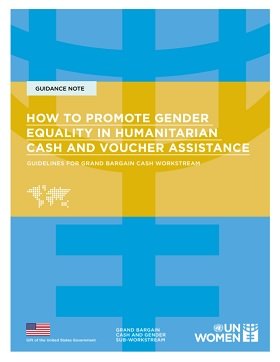
How to Promote Gender Equality in Humanitarian Cash and Voucher Assistance
Guidelines and Tools
The use of cash and voucher assistance (CVA) in humanitarian action is increasing rapidly.
With this rise, there is also growing demand by stakeholders to ensure CVA is more gender-responsive, addressing gender gaps and moving towards greater gender equality.
Gender-responsive CVA, which recognizes existing disparities and addresses the needs of all crisis-affected people equally, has the...
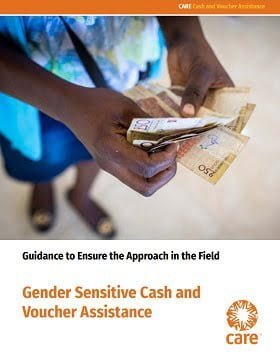
Gender-Sensitive Cash and Voucher Assistance: Guidance to ensure the approach in the field
Guidelines and Tools
This guidance builds on CARE’s ambition-via practice, research, evidence on CVA–and aims to support the application of gender sensitive CVA throughout the project cycle and at the response level. It is divided into two sections: – Part A: ‘What has been learned about gender sensitive CVA?,’ briefly explains the recommendations that came from the research. – Part B: ‘How do we...

Enablers and Gaps: Gender Equality, Gender-Based Violence Response and Mitigation in Cash and Voucher Assistance at Response levels: analysis on three case studies
Report
The Gender and Cash Sub-Workstream identified three case studies that illustrate how Cash Working Groups, GBV Sub-Clusters, gender focal points (e.g. Gender in Humanitarian Action Working groups at country and regional level) and humanitarian partnerships can enable meaningful and wider engagement on gender equity and GBV response in CVA. The case studies all show different aspects of linking...

How to mitigate gender-based violence (GBV) risks in cash and voucher assistance (CVA)
Video
Cash and voucher assistance (CVA) is an important tool to help individuals affected by crises get back on their feet. But just like any other form of assistance, it is vital to ensure that it does not fuel tensions in the household or in the community and that it does not create new risks for women and girls. Fortunately, there are a variety of ways that cash actors can work to mitigate risks...

Inclusive Information Systems for Social Protection: Intentionally Integrating Gender and Disability
Policy paper
Digital information systems serving the social protection sector, and especially social assistance, are increasingly prominent and will continue to be, as is the case within all other sectors. “Why? Because the ability of a country to care for its people and respond to their lifecycle needs depends on its ability to identify those who are in need, enroll them, provide tailored benefits and...
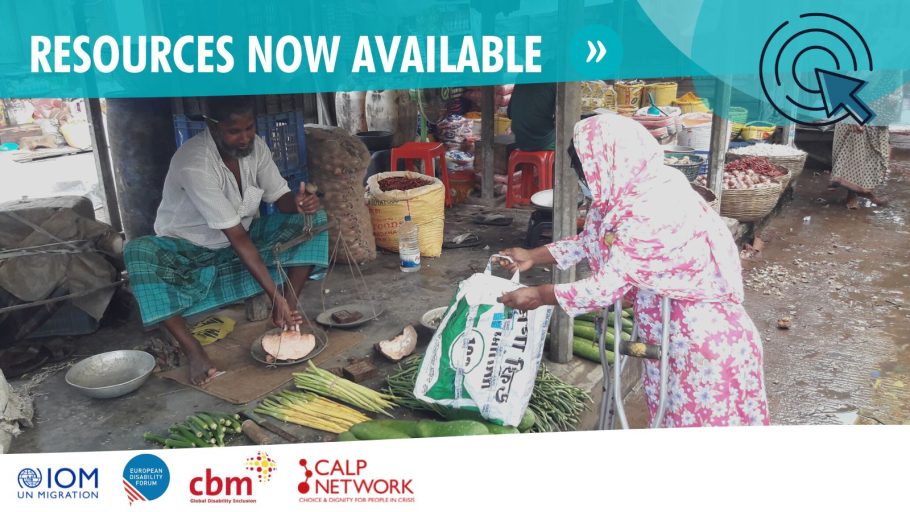
Mainstreaming disability inclusion into humanitarian CVA
Presentation
What is a rights-based approach to disability? How can disability inclusion be mainstreamed to ensure more inclusive and effective CVA humanitarian responses? To answer these key questions, CALP, CBM Global, European Disability Forum and International Organization for Migration (IOM), came together to organize the webinar “Mainstreaming disability inclusion into humanitarian CVA”, with the...
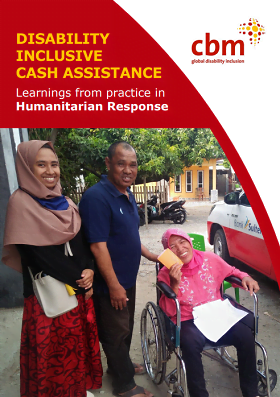
Disability Inclusive Cash Assistance: Learnings from Practice in Humanitarian Response
Guidelines and Tools
This case study collection describes lessons learned from seven inclusive humanitarian cash transfer projects implemented from 2015 – 2020 in Niger, Zimbabwe, Pakistan, Bangladesh, Philippines, and Indonesia, and five ongoing projects from the 2020 Covid-19 pandemic responses. This good practice collection aims to benefit both humanitarian practitioners engaged in Cash Based Interventions...
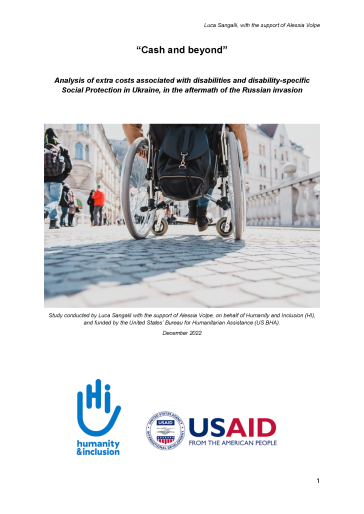
Cash and beyond – Analysis of extra costs associated with disabilities and disability-specific social protection in Ukraine, in the aftermath of the Russian invasion
Report
Following the escalation of the conflict in Ukraine in February 2022 and the consequent humanitarian crisis, the country has experienced active fighting and massive displacement, both within and outside its borders. Persons with disabilities and older persons have been facing particularly harsh effects, especially for those with more severe forms of disabilities, who encountered challenges in...
Thematic lead
Latest

Humanitarian Exchange: Special feature. New learning in cash transfer programming
Report
The special feature of this issue of Humanitarian Exchange, co-edited with Sarah Bailey and Breanna Ridsdel, focuses on new learning in cash transfer programming. While cash is now an accepted tool, and is increasingly being used in humanitarian response, most programmes are small and gaps in analysis and...
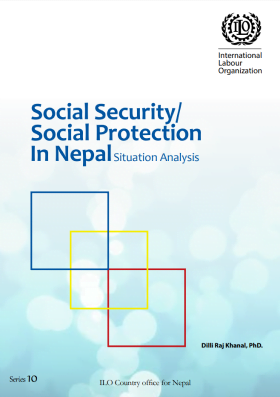
Social Security/Social Protection In Nepal: Situation analysis
Report
The International Labour Conference has outlined several strategies to extend social security by closing coverage gaps and pointed out that effective national strategies should be formed in line with national priorities, administrative feasibility and affordability. The primary goal is to ensure that no...

Cash Transfers in Nairobi’s Slums
Report
In Kenya, a combination of factors led to the food crisis of 2008–9, which put around 9.5 million people at risk of starvation. About 4.1 million of those affected were living in informal settlements (slums) in the capital, Nairobi. Oxfam and Concern Worldwide developed a joint programme to address...

Emergency Food Security and Livelihoods (EFSL) 48-hour training materials to print
Guidelines and Tools
Developed by Oxfam and supporting ECB agencies, the EFSL training materials can be used to train participants to confidently apply the ‘48-hour assessment tool’ to assess the impact of a shock/hazard on an affected population’s food security and livelihoods. This resource includes all printing...
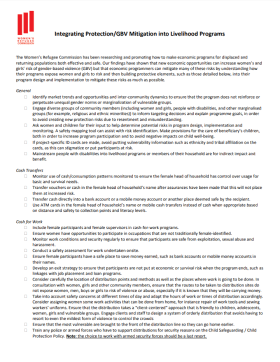
Integrating Protection/GBV Mitigation into Livelihoods Programmes
Guidelines and Tools
The Women’s Refugee Commission has been researching and promoting how to make economic programs for displaced and returning populations both effective and safe. Our findings have shown that new economic opportunities can increase women’s and girls’ risk of gender-based violence (GBV) but that...
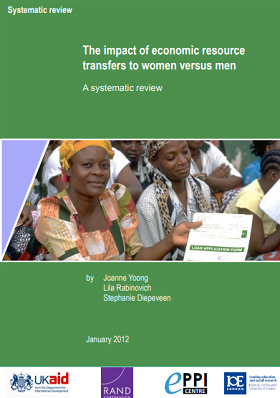
The Impact of Economic Resource Transfers to Women versus Men: A Systematic Review
Report
This systematic review examined the question: “what is the evidence of the impact on family well-being of giving economic resources to women relative to the impact of giving them to men?” This review is of interest to policy-makers and funders in developed and developing countries, given the recent...
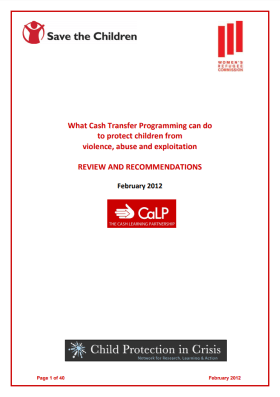
What Cash Transfer Programming can do to Protect Children from Violence, Abuse and Exploitation – Review and recommendations
Report
This discussion paper examines the links between cash transfers and the positive and negative outcomes for children, in particular the role cash transfers have played in protecting children from harm, exploitation, abuse and violence. The objective of this paper is to identify ways in which cash transfer...
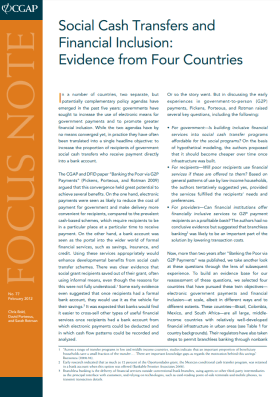
Social Cash Transfers and Financial Inclusion: Evidence from four countries
Report
This focus note from CGAP looks at social cash transfers and how this is being used to improve financial inclusion. To do so they look at examples from Brazil, Colombia, Mexico and South Africa. The focus note compares the various payment approaches, how these interlink with the respective government...

Examining Differences in the Effectiveness and Impacts of Vouchers and Unconditional Cash Transfers
Report
The objective of this study is to examine the differences in the effectiveness and impacts of vouchers versus unconditional cash transfers in the Bushani camp of the Masisi territory of the Democratic Republic of Congo. As part of this research, the study team collected household data from over...
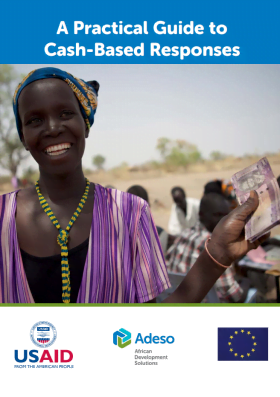
A Practical Guide to Cash-Based Response
Guidelines and Tools
A Practical Guide to Cash-based Responses is a manual developed by Adeso to share the organisation’s experience in developing and implementing appropriate cash-based responses. The manual highlights some practical problems that are faced by implementation teams around the world and it is intended to...
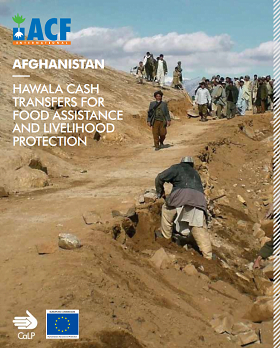
Afghanistan: Hawala Cash Transfers for Food Assistance and Livelihood Protection
Case Study
In response to repeated flooding, ACF implemented a cash-based intervention in the Samangan and Day Kundi Provinces of Afghanistan. The project applied cash for work activities as well as unconditional cash transfers and made use of the local Hawala system to securely transfer money to beneficiaries. The...

Impact Evaluation of Cash, Food Vouchers, and Food Transfers among Colombian Refugees and Poor Ecuadorians in Carchi and Sucumbíos
Report
This report is the final impact evaluation of the World Food Programme’s Food, Cash, and Voucher intervention and contains analysis on outcomes including food security, social capital, anemia, and gender issues. Due to the targeting of Colombian refuges and poor Ecuadorians in Northern Ecuador, it also...

Good Practice Review 11: Cash transfer programming in emergencies
Guidelines and Tools
The GPR is intended for humanitarian practitioners who plan and implement emergency responses – both those who are already familiar with cash-based interventions and those who are not. It synthesises cash transfer guidelines, highlights lessons from evaluations and adds practical examples drawn from...
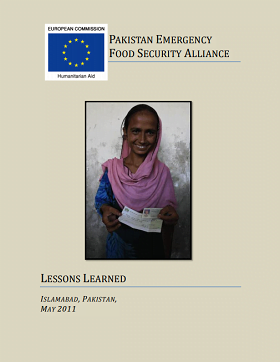
Pakistan Emergency Food Security Alliance: Lessons Learned
Report
In response to the unprecedented scale of flooding that affected Pakistan in July 2010, six INGOs – Save the Children, Oxfam GB, IRC, CARE, ACTED and Action Against Hunger / ACF International – formed the Pakistan Emergency Food Security Alliance (PEFSA). Working together in order to maximize the...
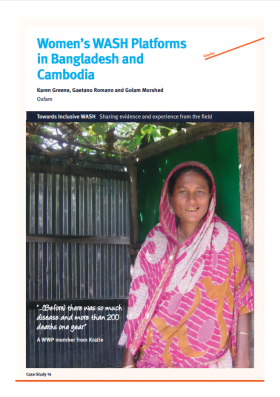
Women’s WASH Platforms in Bangladesh and Cambodia
Case Study
Oxfam’s multi-country portfolio is located in more than 100 remote rural communities in six countries and is funded by AusAID’s Civil Society Organisation WASH Fund. The water, sanitation and hygiene (WASH) projects in Bangladesh and Cambodia deliver multiple outcomes including improving water and...
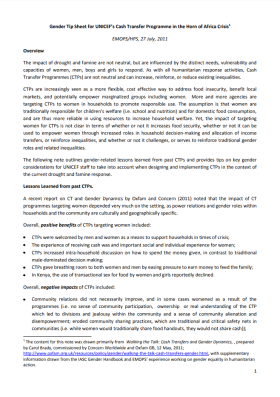
Gender Tip Sheet for UNICEF’s Cash Transfer Programme in the Horn of Africa Crisis
Guidelines and Tools
The content for this note was drawn primarily from Walking the Talk: Cash Transfers and Gender Dynamics, prepared by Carol Brady, commissioned by Concern Worldwide and Oxfam GB, 12 May, 2011. Drafted for UNICEF staff, this note outlines gender-related lessons learned from past CTPs and provides tips on...
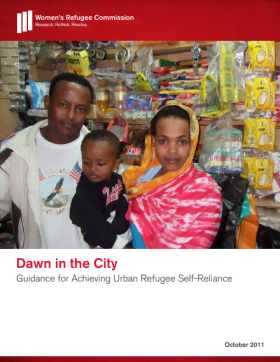
Dawn in the City: Guidance for achieving urban refugee self-reliance
Report
More than 50 percent of refugees live in urban areas. Eighty percent are hosted by developing nations, in cities ill-equipped to guarantee their protection. The majority are marginalized due to their legal, economic and social status. They frequently lack sufficient legal and social...
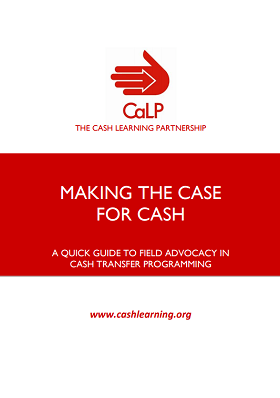
Making the Case for Cash: A field guide to advocacy for cash transfer programming
Guidelines and Tools
Because cash transfer programming (CTP) is still a relatively new way of delivering aid, practitioners may often find that they need to be able to make the case for using CTP as well as address fears across different audiences. This guide aims to support field-level advocacy for cash transfer programming....
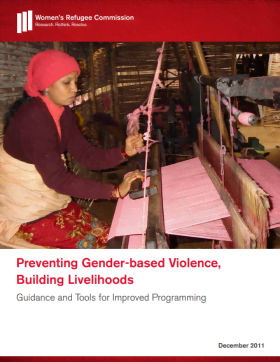
Preventing Gender-Based Violence, Building Livelihoods: Guidance and tools for improved programming
Guidelines and Tools
Conflict and displacement destroy livelihoods and force people to adopt new strategies to support themselves. New livelihood strategies can increase the risk of gender-based violence (GBV). Women often have no safety net; they usually flee with few resources and little preparation and may become...
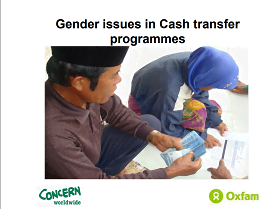
Gender issues in Cash transfer programmes
Presentation
Purpose of the study: To assess the changes in gender power relations within households and in the community, as a result of emergency cash transfer programmes. To review the processes followed by agencies in emergency cash transfer programming and analyse their adequacy from a gender perspective
